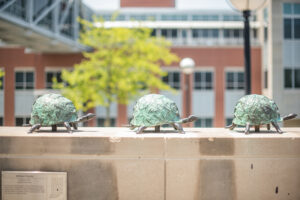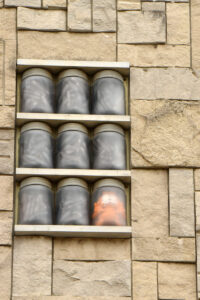Published September 11, 2023
Restoring the Icons of the 92 County Walk
By Meghan Smith, Conservation Lab Manager
When you come to the Indiana State Museum, you might not notice the icons of the 92 County Walk right away. But maybe, out of the corner of your eye, you’ll see something interesting around the building. Is that a round barn? Or a typewriter? Or… Garfield?
The answer is yes! Each of Indiana’s 92 counties is represented by a unique sculpture somewhere on the museum’s campus. Some icons are quite easy to spot while others are in more out-of-the-way places. (Happy hunting for Orange and Franklin counties!) Each sculpture contains design elements that refer to something notable and unique about that particular county.
Many of the 92 County Walk icons were made of timeless, durable materials, like limestone and metal, while others incorporated more modern materials, like plastic, resin and even electric motors and lights. These sculptures remained outside, subject to weather and temperature extremes. Some are positioned high on the building, unreachable without the aid of construction lifts. Others are within easy reach of the public, leaving them vulnerable to vandalism and theft. Indiana State Museum conservation staff monitored the icons over the years, documenting changes and cleaning them periodically. As time passed, a repair and replacement program was established to revitalize the aging icons.
 Metalworking artist Julie Ball has assisted with restoring several icons, starting with the Johnson County sculpture. This piece features three bronze turtles cast from military helmets, giving a nod to both Camp Atterbury and the natural history of the area. Only a few years after the turtles were installed, one of them was stolen. Ball and her staff removed the remaining two, cast a replacement third and re-installed them more securely to hopefully prevent future theft. Similar work was done on the Parke County icons, a cluster of bronze covered bridges jutting out from the terrace wall near the canal. Their location on a busy pedestrian path made them vulnerable, and over the years, several were pulled from the wall and never seen again. Ball replicated the missing bridges and anchored them more securely to deter future theft.
Metalworking artist Julie Ball has assisted with restoring several icons, starting with the Johnson County sculpture. This piece features three bronze turtles cast from military helmets, giving a nod to both Camp Atterbury and the natural history of the area. Only a few years after the turtles were installed, one of them was stolen. Ball and her staff removed the remaining two, cast a replacement third and re-installed them more securely to hopefully prevent future theft. Similar work was done on the Parke County icons, a cluster of bronze covered bridges jutting out from the terrace wall near the canal. Their location on a busy pedestrian path made them vulnerable, and over the years, several were pulled from the wall and never seen again. Ball replicated the missing bridges and anchored them more securely to deter future theft.
Tucked over a door leading from the café to the outdoor terrace, the Randolph County icon is a large glass panel with a semi-abstract pattern of swirling cornstalks, dotted with gold leaf accents. Its coloring changes depending on the time of day and weather. The design and medium come together to tell the story of Randolph County’s agricultural heritage alongside its glass manufacturing industry. The enameled surface responsible for the piece’s blue-green coloration has deteriorated significantly over the two decades since its installation. We turned to Greg Thompson of GRT Glass to repair the panel. To slow down future deterioration of the artwork, Thompson turned the enameled surface to face indoors, rather than out. It changes the view slightly for outside visitors, but it’s a reasonable price to pay for an icon that will last significantly longer.
 The biggest conundrum currently on our to-do list is Delaware County, which is also my favorite. It’s a set of nine Ball jars; all filled with pickles, except one that contains Garfield. The icon we have today is the second version, as the first jars filled with water during a rainstorm. Though this set of jars doesn’t have any leaks, the acrylic surface is clouded, and the pickles are faded. We are researching different materials that might be both strong enough to withstand the elements and resistant to UV degradation. It’s possible we might completely rethink the icon, selecting different materials to achieve the same effect as the original.
The biggest conundrum currently on our to-do list is Delaware County, which is also my favorite. It’s a set of nine Ball jars; all filled with pickles, except one that contains Garfield. The icon we have today is the second version, as the first jars filled with water during a rainstorm. Though this set of jars doesn’t have any leaks, the acrylic surface is clouded, and the pickles are faded. We are researching different materials that might be both strong enough to withstand the elements and resistant to UV degradation. It’s possible we might completely rethink the icon, selecting different materials to achieve the same effect as the original.
This spring and summer, our in-house team rehabilitated the Marshall County icon, which represents the blueberry bushes that grow abundantly in that region. Blue glass “berries” are set into limestone, and layers of blue and purple paint rough out the shape of Lake Maxinkuckee. The materials have degraded over the years, leaving the sculpture colorless and down quite a few marbles. Our Arts and Culture Collections Manager Meredith McGovern sourced appropriate paint colors and provided artistic direction (and superior painting skills). Over several sessions, we layered on paint and glued in marbles, consulting images of the original icon to keep the new work as faithful as possible to the old. The result is a joyful, colorful explosion celebrating one small corner of Indiana.
Our work on the icons is far from finished — in fact, it never will be. Someday, even the sturdiest limestone sculptures will naturally begin to show wear. Our task will be to shepherd all 92 artworks through the years so that future Indiana State Museum visitors can find the same delight in these sculptures that we do today.








